Monomorium pharaonis (L.)
  Type location Egypt (Formica
pharaonis, Linnaeus, 1758: 580, worker; Mayr, 1865: 90, male;
André, 1883a: 338, queen; Forel, 1891b: 164, all forms) - no type
images on Antweb (February 2015) Type location Egypt (Formica
pharaonis, Linnaeus, 1758: 580, worker; Mayr, 1865: 90, male;
André, 1883a: 338, queen; Forel, 1891b: 164, all forms) - no type
images on Antweb (February 2015)
junior synonyms
antiguensis (Formica
antigueensis, Fabricius, 1793: 357, worker) from West Indies, Antigua - no images on Antweb
(February 2015)
contigua (Myrmica
contigua, F Smith, 1858b: 125, queen) from Sri Lanka - see http://www.antweb.org/specimenImages.do?name=casent0102682
domestica (Myrmica
domestica, Shuckard, 1838: 627, worker & queen; F Smith,
1851: 119, male) from Great Britain -
no images on Antweb (February 2015)
fragilis (Myrmica
fragilis, F Smith, 1858b: 124, worker) from Singapore - see http://www.antweb.org/specimenImages.do?code=casent0102330
vastator (Myrmica
vastator, F Smith, 1857a: 71, worker) from Singapore - see http://www.antweb.org/specimenImages.do?name=casent0008625
minuta (Atta minuta N.S., Jerdon, 1851:
105,worker & queen) from India-
no images on Antweb (February 2015)
(see Bolton, 1995)  . .
|
The Linnaeus (1758) description is at  . Mayr's (1865) description of the male is
at . Mayr's (1865) description of the male is
at  . Jerdon's (1851) description of minuta
is at . Jerdon's (1851) description of minuta
is at  Arnold (1916: 228) gave a fuller
description, based apparently on the F Smith descriptions (1851 &
1855), this is at Arnold (1916: 228) gave a fuller
description, based apparently on the F Smith descriptions (1851 &
1855), this is at  Bolton's modern
description (1987) is at Bolton's modern
description (1987) is at  . .
|
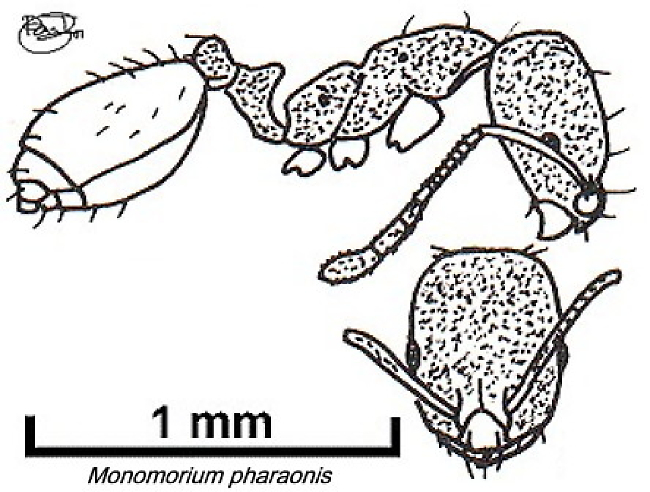 Nigeria specimen (Monomorium
prossae/?pharonis in Taylor, 1980a: 29). WORKER. TL 2.52 mm, HL
0.57, HW 0.44, SL 0.49, PW 0.28 Nigeria specimen (Monomorium
prossae/?pharonis in Taylor, 1980a: 29). WORKER. TL 2.52 mm, HL
0.57, HW 0.44, SL 0.49, PW 0.28
Colour yellow-orange, apex of gaster dark. Head, alitrunk and pedicel
finely and densely reticulopunctate. Erect hairs relatively long and
moderately abundant on the head and gaster. Antennae 12-segmented.
Sides of head convex in front view with a smooth curve to a slightly
convex occipital margin.
Collected in buildings and "sweeping grass" at the Cocoa Research
Institute of Nigeria, Idi Ayunre, by B. Bolton.
|
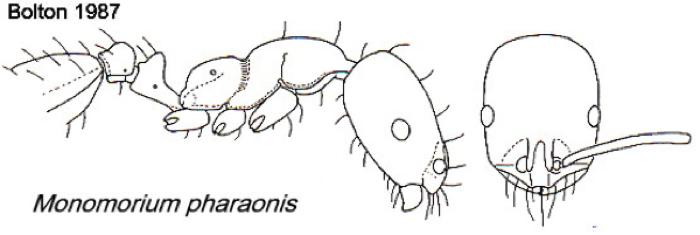 Others
TL 2.2-2.4 mm (Bolton, 1987: 356, illustrated, full-face view, body
profile). Others
TL 2.2-2.4 mm (Bolton, 1987: 356, illustrated, full-face view, body
profile).
A very successful tramp species with a world-wide
distribution, including in heated buildings in temperate countries
(Bolton & Collingwood, 1975). Bradshaw & Howse (1984) described
it as a mass-recruiting species, using glandular secretions to repel
larger ant species.
|
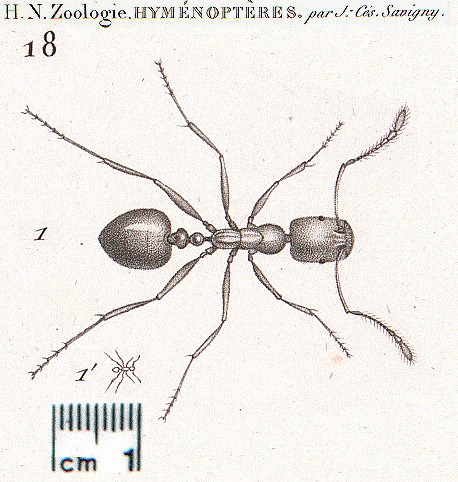 From
Egypt, what appears to be pharaonis was
illustrated by Savigny (Audouin, J.-V. 1825-27: Plate 20 Fig 18). From
Egypt, what appears to be pharaonis was
illustrated by Savigny (Audouin, J.-V. 1825-27: Plate 20 Fig 18).
|
|
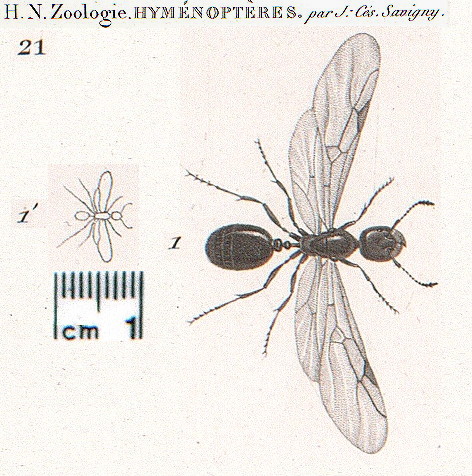 From
Egypt, what appears to be a salomonis queen
was
illustrated by Savigny (Audouin, J.-V. 1825-27: Plate 20 Fig 18). From
Egypt, what appears to be a salomonis queen
was
illustrated by Savigny (Audouin, J.-V. 1825-27: Plate 20 Fig 18).
Sharaf list - material examined: type form - El-Sabah
Emarat, 50 km Ismailia-Cairo, 14.iii.2002 (9); Cairo, 14.viii.2002
(12); 20 km Alexandria-Cairo, 8.iv.2001 (16); Gebel Asfar (Qalyubiya),
29.iv.2003 (19); El-Nagdein (Siwa) (3); El-Karnak temple (Luxor),
4.iii.2003 (5); Khniza (Nubaria), 21.ix.2002 (11); Zaranik (North
Sinai), 11.viii.2000 (7); Alag, 27.ii.2003 (17); Kharga oasis,
7.xi.1997 (3); El-Taifa (Kafr El-Sheikh), 27.viii.2003 (14); Mafareq
(South Sinai), 12.vii.1998 (2); Hawamdyia (Giza), 2.xi.2002 (2);
Zaranik (North Sinai), 30.viii.2000 (3) (SHC); Mafareq (South Sinai),
12.vii.1998 (1) Leg.M.R.Sharaf; Mafareq (South Sinai), 10.viii.1998 (1)
Leg.M.R.Sharaf. (ASUC); Giza, 5.i.1953 (CUC).
sommieri form - material examined: Ein Sokhna,
13.ii.1999 (1); Wadi El-Arish, 14.iii.2002 (8); El-Sabah Emarat, 50 km
El-Arish -Ismailia road, 14iii.2002 (12); Salhyia, 14.iii.2002 (5);
El-Tor (South Sinai), 9.iii.1999 (3) (Leg. M.S.Abdel-Dayem); Salhyia,
14.iii.2002 (13); Wadi El-Rayan (Faiyum), 7.xi.2001 (1); Ismailia,
13.xii.1997 (5); Zaranik (North Sinai), 11.viii.2000 (5); Abu-Madi,
Zaranik (North Sinai), 6.v.2003 (5); Wadi El-Arish, 14.iii.2002 (5)
(SHC); Sahab (South Sinai), 18.xi.1999 (2) Leg.M.R.Sharaf; Sahab (South
Sinai), 10.viii.1998 (1) Leg.M.R.Sharaf; Wadi El-Arbaein, St.Catherine
(South Sinai), 1.iv.1998 (1) Leg.M.R.Sharaf (ASUC).
Mohamad (1979) thesis had Burg El-Arab (Alexandria),
17.iv.1952; Rosetta, 19.iv.1952; Wadi Degla (Helwan), 4.viii.1952;
16.iii.1955; Wadi El-Tih (Sinai), 26.ii.1954; Marsa Matrouh,
20.viii.1955; Kom Oshim (Fayium), 28.ii.1975; Heliopolis, 12.iv.1975;
Wadi El-Natroun (Western desert), 5.x.1975; Mariut, 16.x.1975;
El-Zagazig (Nile Delta), 1.vii.1975; Ismailia, 1.viii.1975; Damietta,
15.viii.1975; Siwa oasis (Western desert), 9-4.iv.1976; Ras Gharib (Red
Sea), 22.i.1978; 23.i.1978; Kom Hamada, 3.ii.1978; Dakhla oasis
(Western desert), 1-4.ii.1978; Baharyia oasis (Western desert),
4,7.iii.1979 (Coll.Ain.) Giza, 5.i.1953 (Coll.Car.)
Ecological note (M Sharaf) - this species was collected
from an area cultivated with palm trees in Alag, Qalyubiya; and was
present in large numbers under a layer of fallen leaves on the ground;
it was also collected from Aswan, near the high dam, under graminae
plants.
|
Oxford University Museum
specimens
Monomorium pharaonis
B Taylor det. |
Egypt
M R Sharaf
|
13.vi.2003
Abuzabal
30°15'N
31°21'E
|
Qaliobia
|
1
|
 |
|
 The
photomontage is of a worker from Egypt, Abuzabal; collector M
Sharaf. The
photomontage is of a worker from Egypt, Abuzabal; collector M
Sharaf.
|
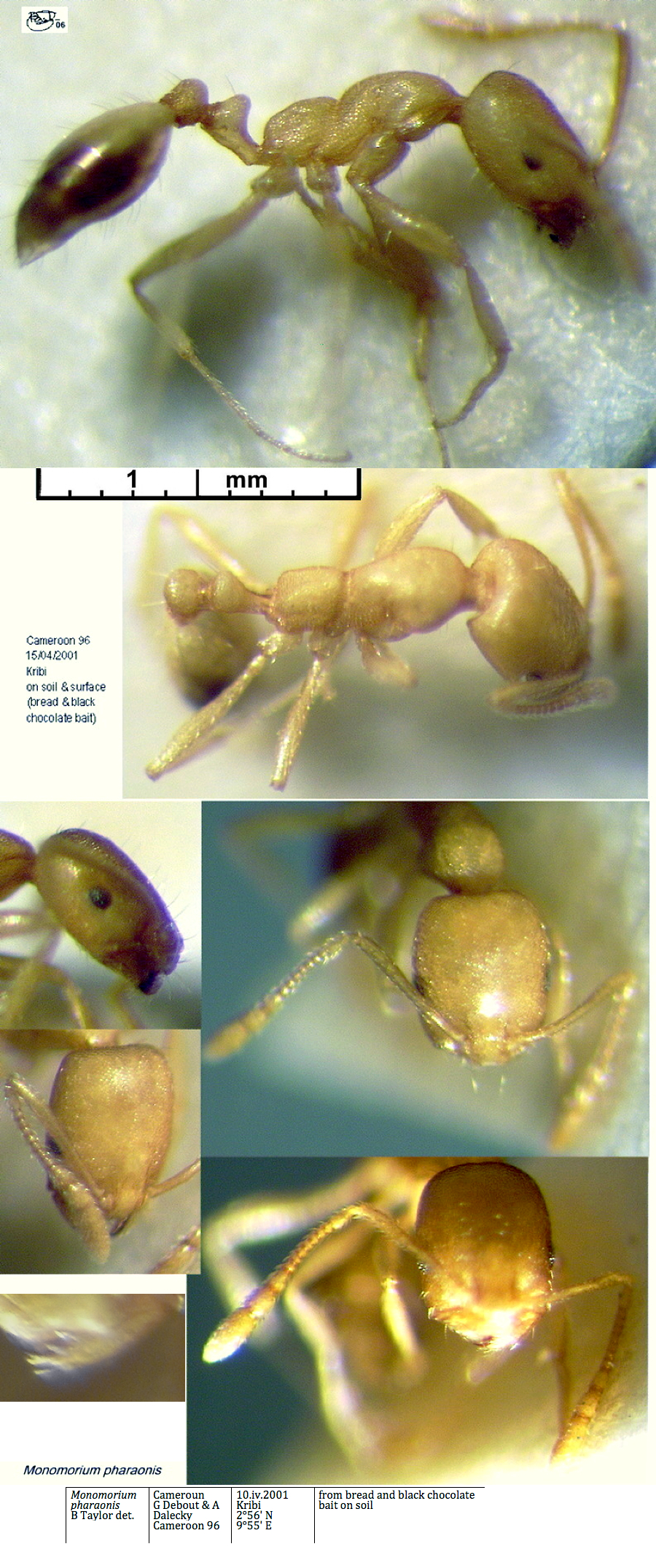 The
photomontage is of a worker collected in Cameroun -
south-western tropical coastal forest area between Edéa and Campo
(McKey Wolbachia project, Cameroon 96). The
photomontage is of a worker collected in Cameroun -
south-western tropical coastal forest area between Edéa and Campo
(McKey Wolbachia project, Cameroon 96).
|
 The
photomontage is of a queen collected in Cameroun -
south-western tropical coastal forest area between Edéa and Campo
(McKey Wolbachia project, Cameroon 96) The
photomontage is of a queen collected in Cameroun -
south-western tropical coastal forest area between Edéa and Campo
(McKey Wolbachia project, Cameroon 96)
|
|